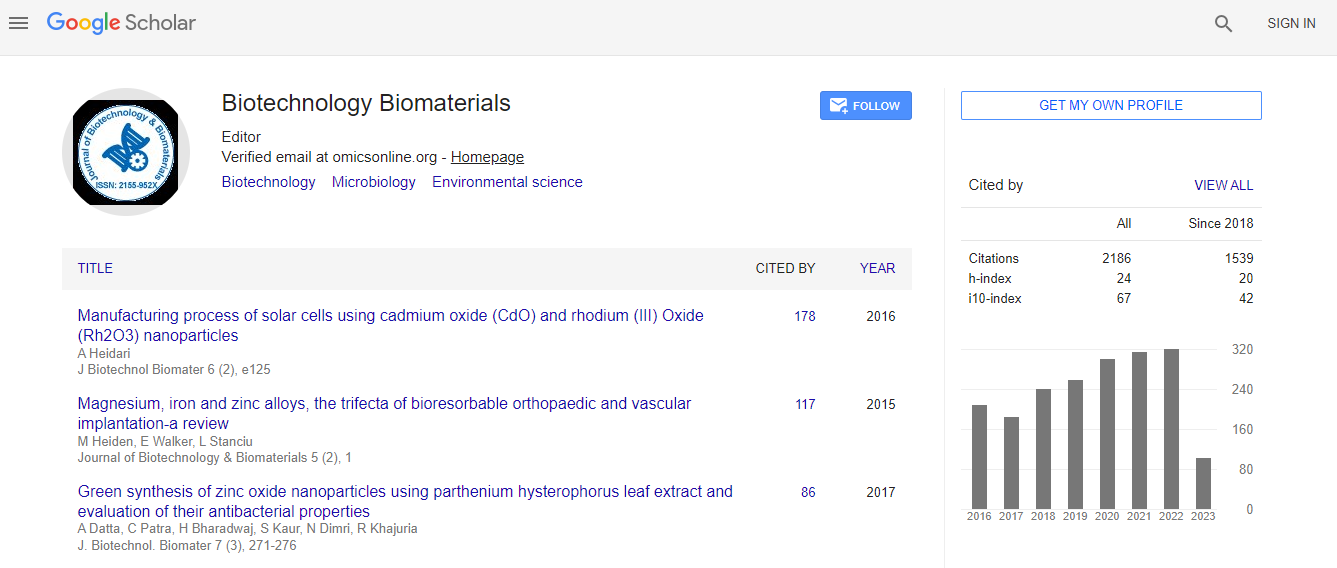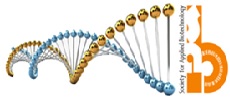Our Group organises 3000+ Global Conferenceseries Events every year across USA, Europe & Asia with support from 1000 more scientific Societies and Publishes 700+ Open Access Journals which contains over 50000 eminent personalities, reputed scientists as editorial board members.
Open Access Journals gaining more Readers and Citations
700 Journals and 15,000,000 Readers Each Journal is getting 25,000+ Readers
Google Scholar citation report
Citations : 3330
Journal of Biotechnology & Biomaterials received 3330 citations as per Google Scholar report
Indexed In
- Index Copernicus
- Google Scholar
- Sherpa Romeo
- Open J Gate
- Genamics JournalSeek
- Academic Keys
- ResearchBible
- China National Knowledge Infrastructure (CNKI)
- Access to Global Online Research in Agriculture (AGORA)
- Electronic Journals Library
- RefSeek
- Hamdard University
- EBSCO A-Z
- OCLC- WorldCat
- SWB online catalog
- Virtual Library of Biology (vifabio)
- Publons
- Geneva Foundation for Medical Education and Research
- Euro Pub
- ICMJE
Useful Links
Recommended Journals
Related Subjects
Share This Page
Stopping biological time: Science and art of biostabilization
21st European Biotechnology Congress
Igor L Katkov
Celltronix, USABelgorod National State Research University, Russian Federation
Keynote: J Biotechnol Biomater
Abstract
Biostabilization (a.k.a. biopreservation) is a process that leads to cessation of the basic chemical and biological reactions so the biosamples can be pooled and stored (biobanked) for long time. There are 5 basics ways of achieving long-term storage, which ALL essentially lead to vitrification of cells, namely: slow freezing (SF), equilibrium vitrification (E-VF), kinetic vitrification (K-VF), freeze-drying (lyophilization) and vacuum/air flow drying at temperatures above 0°C (xeropreservation). Different combinations of the 5 basic biopreservation technologies such a preliminary drying before cryogenic slow freezing or vitrification is also possible. Author will discuss a phase diagram that shows all 5 basic ways of biostabilization and will discuss pros and cons of all approaches. A special emphasis will be put on the kinetic vitrification as it does not require the high concentrations of (or does not need at all) potentially toxic and osmotically damaging exogenous permeable intracellular vitrificants (also called cryoprotectants). Author will also present KrioBlast-2, a pilot version of the KrioBlast™ platform for cryopreservation by K-VF. Preliminary experiments on K-VF of human pluripotent stem cells and spermatozoa, which showed an equally excellent (80-90% of the untreated control) will be also discussed. A more advanced version KrioBlast-3 will be discussed in the concurrent presentation. Recent Publications 1. Katkov II, Bolyukh A F, Chernetsov O A, Dudin P I et al. (2012) Kinetic Vitrification of Spermatozoa of Vertebrates: What Can We Learn from Nature? In: Current Frontiers in Cryobiology, Eds: I I Katkov. DOI: 10.5772/34784. 2. Katkov II (2014) Stopping biological clocks: The science and art of biopreservation. BioProcess International 12(4):42- 52. 3. Katkov II, Bolyukh V F and Sukhikh G T (2017) KrioBlastТМ as a new technology of hyper-fast cryopreservation of cells and tissues, Part I. Thermodynamic aspects and potential applications in reproductive and regenerative medicine. Bulletin of Experimental Biology and Medicine 164:230-235.Biography
Igor L Katkov is a trained biophysicist with 30+ years of experience in cryobiology and cryogenic engineering. His last years of research have been focused on the fundamental aspects of kinetic vitrification (K-VF) as well on designing the practical system for K-VF KrioBlast™ (in cooperation with V F Bolyukh). Currently, the Head of the Laboratory of the Amorphous state at the Belgorod National Research University BelSU, Russia. He has recently accepted a Professor level position as the Head of the Laboratory of Cryobiology at the V I Kulakov Research Center of Obstetrics, Gynecology and Perinatology (RCGOP), Moscow, Russia and Chief Scientific Officer of Celltronix, San Diego, CA, USA.
E-mail: prodvincell@hotmail.com

 Spanish
Spanish  Chinese
Chinese  Russian
Russian  German
German  French
French  Japanese
Japanese  Portuguese
Portuguese  Hindi
Hindi 
